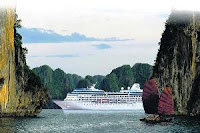I’ve always thought that wine and cruising made a great combination. Even if a glass of wine (or two) isn’t part of your daily routine at home, it’s easy to get into the habit while cruising on the Mediterranean or the European rivers. Whether you’re admiring the lush Rhône Valley vineyards from your perch on the Sun deck or enjoying the vineyard-rich, UNESCO-designated Wachau Valley while savoring a Sacher Torte in the dining room, you will undoubtedly find yourself in the mood to sip a glass of wine while cruising in these renowned wine-growing regions.
 • The Blue Danube Discovery Wine River Cruise from Budapest to Prague on the Avalon Tranquility, July 15-27 and from Prague to Budapest on the Avalon Tranquility, October 27-November 6. You will participate in a wine tasting excursion in Budapest or Prague and visit a Wachau wine cellar in Melk. While onboard, you will attend an Austrian sweet wine lecture and tasting and enjoy a food and wine pairing gala dinner. Do you know the difference between an Austrian Grüner Veltliner and a German Riesling Spälese? It is one of the many things you will learn on this cruise.
• The Blue Danube Discovery Wine River Cruise from Budapest to Prague on the Avalon Tranquility, July 15-27 and from Prague to Budapest on the Avalon Tranquility, October 27-November 6. You will participate in a wine tasting excursion in Budapest or Prague and visit a Wachau wine cellar in Melk. While onboard, you will attend an Austrian sweet wine lecture and tasting and enjoy a food and wine pairing gala dinner. Do you know the difference between an Austrian Grüner Veltliner and a German Riesling Spälese? It is one of the many things you will learn on this cruise.• Windmills, Vineyards, & Paris Wine River Cruise from Paris to Amsterdam on the Avalon Luminary, October 3-15. You will explore the Moselle wine-growing region, visit the charming wine village of Bernkastel and taste several of the region’s varietals, attend fascinating lectures on French and German wines and enjoy a food and wine pairing gala dinner onboard.
 • Burgundy & Provence Wine River Cruise from Arles to Paris on the Avalon Scenery from October 31-November 10. You will tour a wine cellar in Beaune and have the opportunity to taste some of France’s famed Burgundy, Chardonnay and Châteauneuf-du-Pape wines. On board the Avalon Scenery, you will be treated to a Beaujolais wine tasting, a food and wine pairing dinner gala dinner and a wine and chocolate tasting.
• Burgundy & Provence Wine River Cruise from Arles to Paris on the Avalon Scenery from October 31-November 10. You will tour a wine cellar in Beaune and have the opportunity to taste some of France’s famed Burgundy, Chardonnay and Châteauneuf-du-Pape wines. On board the Avalon Scenery, you will be treated to a Beaujolais wine tasting, a food and wine pairing dinner gala dinner and a wine and chocolate tasting. Are you a member of a Wine Club? Do you have a favorite sommelier who knows his or her way around the wine regions in Europe? Then let me help you design your dream wine cruise. We’ve all heard of food and wine pairings. I think it’s time to do some cruise and wine pairings!






















































